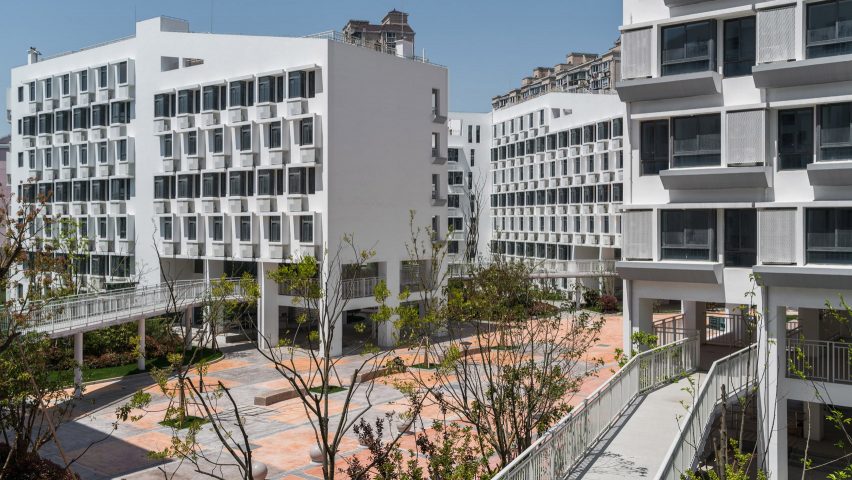Our next Social Housing Revival case study is Atelier GOM's Shanghai Longnan Garden estate, the first social-housing project in China to abandon high-rise towers.
Located in Shanghai's central Xuhui district, the 100,000-square-metre Longnan Garden estate was completed in 2017.
Commissioned by the district's state-owned Assets Supervision and Administration Commission as low-rent housing, it comprises one commercial building and seven residential buildings containing a total of 2,000 homes.
Four seven-storey buildings at the north part of the complex adopt a U-shaped semi-enclosed courtyard layout, while the three blocks at the south feature step-down roofs, varying between seven storeys to 17 storeys in height.
This approach was a significant departure from the high-rise-tower format that has long dominated China's housing landscape.
Jiajing Zhang, chief architect at Shanghai-based architecture studio Atelier GOM, explained that this prevalence of point blocks in Chinese housing is a result of minimum sunlight requirements.
"In China, all housing must meet stringent sunlight requirements to ensure each apartment unit within a residential complex receives minimum sunlight during the day, which presents a significant challenge when it comes to designing a housing form," he told Dezeen.
"High-rise, low-density determinant housing is the easiest solution, while the enclosed courtyard layout is not commonly used for that reason."
At Longnan Garden estate, Atelier GOM wanted to explore how a different combination of height and density could improve the living comfort and viewing experience for the residents while still meeting the regulations.
Its solution was staggered roofs and recessed balconies, which not only allow sunlight to reach every apartment but create space for gardens and public activities.
"Step-down roofs, the heights of the buildings, and the floor-plan design are all carefully calculated to meet the sunlight requirement," said Zhang.
"Here regulation puts restrictions on our design, but also presents opportunities for new solutions," he added.
Open corridors and bridges connect the four courtyard buildings at various levels, referencing an architecture form that is deeply rooted in traditional Chinese garden design, providing more public space for the residents beyond the ground floor.
Elevated two-storey, semi-outdoor spaces are inserted into the courtyard buildings, while a projecting public terrace on every two floors of the north corridor of the buildings is built to receive sunlight from both east and west.
Housing costs have increased dramatically in China since the introduction of a commercial housing market in the 1980s.
The country's first social housing was launched in Chongqing in 2011 with several other cities following suit – but the pace of development has not kept up with demand, resulting in a waiting period of up to three years.
At Longnan Garden estate, the average rent is half the average market rent in the area and at a fixed rate. Any local resident living in a home smaller than 15 square metres is qualified to apply, and demand is high.
Atelier GOM has been involved in housing design in China since 2002, initially to capitalise on the country's post-millennium real-estate development boom.
"Housing developers want to achieve quick land acquisition and high turnover," said Zhang.
"They employ big state-owned design institutes to quickly generate plans that can easily be copied from one project to the next, which ultimately leads to a single, repeated housing model that spreads across the country like a virus, creating a repeated and boring urban landscape."
"The consensus of such a housing development model in China has minimised the role of architects," he added. "You rarely see an independent architect in China doing large-scale housing design."
In a bid to challenge the "increasingly capital-dominated real estate stifling the diversity of residential designs", Atelier GOM launched HouseChatting, a research project focused on housing.
Building number five at Longnan Garden estate, located at the south-west front, came from HouseChatting research on the adaptive reuse of former social housing in Europe.
"After the great demand for social housing decreases, many of them would be sold to be adapted into commercial housing, offices or hotels," explained Zhang. "So the adaptive use of post-social housing needs to be considered in the design."
Atelier GOM came up with a unit concept called Skeleton Infill, first realised in this building.
While most contemporary social housing in China uses a sheer wall structure with a floor height of between 2.7 and 2.9 metres, at building five Atelier GOM created a 7.6-metre-tall concrete frame, or skeleton, and inserted two small loft units into it using steel structures.
The idea was to produce more spacious apartments while also improving the building's adaptability – but Zhang admits that it backfired amid rancour from the construction companies working on the estate.
Construction was heavily delayed, and the poor quality of the finished result means the building suffers from poor sound insulation and water leaks.
"Everything that matches the existing system would run smoothly, and anything that conflicts with the system is inherently sinful," Zhang said of the reaction from construction firms.
It took six years to complete the entire project – significantly longer than the average Chinese housing development – while Zhang recalls facing criticism throughout the process, often over elements beyond his control.
"Well that's the responsibility of an architect," he said. "Despite everything, I will keep doing my job to design buildings that can house more people and allow more people to be able to afford their homes."
"I never wanted to say what I do is better than the existing model, but only want to show the public we can do it in a different way as well."
The photography is by CreatAR unless otherwise stated.
Social Housing Revival
This article is part of Dezeen's Social Housing Revival series exploring the new wave of quality social housing being built around the world, and asking whether a return to social house-building at scale can help solve affordability issues and homelessness in our major cities.

